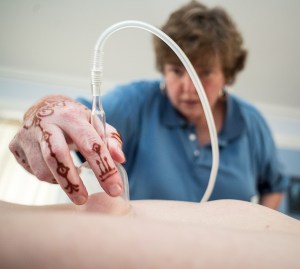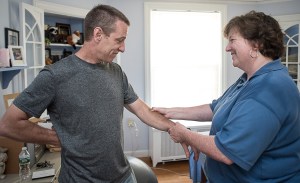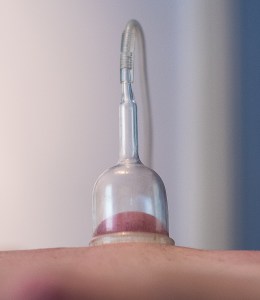LEWISTON — When she was finished manipulating various parts of my body with cups and suction, massage therapist Nancy Callahan asked me to describe the sensation of cupping.
It felt like soft quick kisses at times, I told her. It’s like the early beginnings of a hickey or a gentle nibble when the suction is really cranked up.
I meant that in a good way.
After being subjected to suction and cups along my back, shoulders and calves, I can honestly say this: I felt better coming out of Callahan’s office than I did going in.
It’s not because evil spirits have been released from my flesh as some Native Americans believed. It’s because Callahan, certified in the ancient art of cupping, has broken up fascial restrictions under my flesh, allowing my muscles to move more freely.
How do you like me now?
Of course, cupping has been a hot topic recently since Olympic swimming stud Michael Phelps appeared before the cameras with purplish circles dotting his body, the result of being cupped in preparation for competition.
While she had me face down on her table, Callahan went at my various fascial restrictions with a variety of cups. Some were big, some were small, and all of them felt like they were playfully nibbling my flesh.
Callahan explains the tools of her trade:
“In massage cupping, the therapist uses a hand pump vacuum set and/or a machine,” she said. “I chose the hand pump vacuum cups first but quickly fell in love with the vacuum machine. There are several ways mechanic cups work. The idea is to get the air out to create a vacuum. One can use a silicone cup and squeeze the air out and place on the body. Hand pump cups have a one-way valve on the cup to create a vacuum. It can be difficult to regulate the amount of pressure and be consistent.”
When Callahan found a problem area along the left side of my back, she attached a cup and applied the proper amount of suction. I tell you, it feels like nibbling.
Ten seconds or so later, she removed the cup and manipulated the area with her fingers. What do you know? No more tenderness, no more problem.
The sensation of the cups never seems painful like a traditional massage can be. Callahan explains that this is because the suction is tenderly tugging up on the flesh rather than pressing down on it.
Your results may vary.
“The therapist would start with a light pressure and go over the intended issue and check for client tolerance,” Callahan said. “Tolerance means working within the clients’ comfort level. If cupping hurts, it normally feels like tiny needles or bee stings. Communicate the discomfort to the therapist so they can adjust down the suction. There is no good reason I know of to work beyond the pain tolerance of a client. The machine makes it easy to reduce the pressure and make the work more tolerable. There are methods, like suction and release (without moving the cups) to reduce the discomfort and still work deep.”
Callahan can also use her cups to locate problem areas within the body. It’s sort of like using a metal detector to find coins and jewelry on the beach.
“When using massage cups, the cups should glide across the skin with ease and the skin in the cup should dome,” she explains. “A cup will come off the skin and break the vacuum seal if the skins is too dry, the vacuum pressure too light, or it hits a restriction/adhesion in the soft tissue.”
Cupping can be also be used for lymph drainage, to minimize the appearance of scar tissue and even for cosmetic face-lifts.
It’s a medical procedure dating back to the time of the pharaoh, best left in the hands of those who have been trained to use it.
“Cups are powerful tools,” Callahan said, “but they are only tools. Like an electric saw is a tool, it can be argued that anyone can cut a board but it takes a skilled workman to use it to build a house square and true. The therapist needs to know the modality they are trying to practice with the cups as well as cup safety for it to be an effective treatment. Massage cupping has taken my work to a higher level. I love cups.”
Phelps’ cool purplish circles has resulted in a mad rush for information on cupping. But Callahan explained that not everybody is going to show those colors – those”cup kisses” – so prominently.
“The more profound the problem,” Callahan said, “the more apt you are to color.”
Since my problems weren’t profound at all — a little fascial restriction here, a tiny knot there — when I climbed up off the table, my back was dotted only by very faint ghost rings one would have to squint to see.
Bummer. I did feel better, though.
And now to rush off and win a bunch of medals.
What’s up with those weird rings, or “cup kisses?” Massage therapist Nancy Callahan breaks it down.
“That mark is referred to as ‘coloring’ or ‘cup kisses.’ It is not really a bruise in a classical sense, more a discoloration. I say that because it does not act like a bruise; it does not hurt. There is a theory that coloring occurs because blood and lymph can become trapped between the cells — causing discomfort and limited mobility — and that the cups lifts it to the surface where the lymph system can remove it.
“How long does coloring last? Depends on many factors. I have seen them go away in a day, but generally three to five days for most of my clients if they color. I have seen a few ‘kisses’ last as much as two weeks. It depends on the severity of the discoloration and the activity level of the client. The lymph system ‘cleans’ them up. The lymph system does not have a pump so it requires body movement to move/activate the lymph system (detox). That is why something as gentle as a slow stroll (walk) can be so beneficial to one’s health. It helps move stuff out and through the lymph system.
“If someone colors the first session, the next session usually will not color as profound as the first. A third session will discolor even less than the second and so on until they no longer color during a session. The discoloring seems to be linked with the area dysfunction. When the dysfunction has been resolved, the area will not mark.”
Contact Nancy Callahan, licensed massage therapist, at 207-212-3305 or at [email protected].



Comments are no longer available on this story